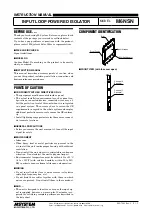
11
QUICK LIFT L520E
EN
• Do not lift any loads directly with the ramps. Always use the supplied rubber spacers in the trays provided for this
purpose.
• The centre of gravity of the vehicle to be lifted shall be midway between the rubber chocks and centred between the
ramps.
PROTOTYPE
Ce document est la propriété de la société GYS et ne peut en aucun cas être transmis à quiconque sans son accord.
Désignation:
Nom du fichier CAO:
Statut:
Indice:
A
Etabli par:
Date:
Feuille:
19_10201
1/1
Mickaël TEXIER
01/10/2019
Études
Assemblage
Produit:
Front ramp
2 m mini.
2 m mini.
2 m mini.
2 m mini.
2/3
1/3
Front ramp
Back ramp
Back ramp
• It is important to ensure that the ramps are parallel to each other and aligned at the front and rear before lifting the
vehicle. Failure to perform this check could result in vehicle instability and lead to a dangerous situation.
There are two special cases when lifting a vehicle with QUICK LIFT, you should be aware of this:
Case 1:
Do not deploy both ramps at full height when unladen. One way to become familiar with the use of your QUICK LIFT is
to raise and lower the ramps several times without putting a load on them (without a vehicle). The frames can lock at
full height when there is no load and if you force the 2 safety bars beyond height 2 simultaneously. If this happens to
you, contact your dealer or the manufacturer.
Case 2:
Do not attempt to lift a vehicle if there is no deployment space above the ramps. Your QUICK LIFT needs a space of a
few centimetres between the wheel chocks and your car so that the pressure gradually increases and lifts the vehicle.
It won’t be able to lift a vehicle in some cases. It’s not a malfunction. This can be problematic if, for example, you lift
a vehicle and once raised you remove the wheels and return the QUICK LIFT to its original position (on the ground).
When you want to pull the vehicle up, the QUICK LIFT will not be able to do so. In this case contact your dealer or the
manufacturer for assistance.










































